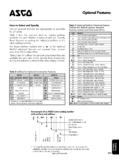Transcription of Checklist of Essential Features of Age-friendly Cities
1 PAGE 1 Checklist of Essential Features of Age-friendly Cities Th is Checklist of Essential Age-friendly city Features is based on the results of the WHO Global Age-friendly Cities project consultation in 33 Cities in 22 countries. Th e Checklist is a tool for a city s self-assessment and a map for charting progress. More detailed checklists of Age-friendly city Features are to be found in the WHO Global Age-friendly Cities Guide. Th is Checklist is intended to be used by individuals and groups interested in making their city more Age-friendly . For the Checklist to be eff ective, older people must be involved as full partners. In assessing a city s strengths and defi ciencies, older people will describe how the Checklist of Features matches their own experience of the city s positive characteristics and barriers.
2 Th ey should play a role in suggesting changes and in implementing and monitoring improvements. Outdoor spaces and buildings Public areas are clean and pleasant. Green spaces and outdoor seating are suffi cient in number, well-maintained and safe. Pavements are well-maintained, free of obstructions and reserved for pedestrians. Pavements are non-slip, are wide enough for wheelchairs and have dropped curbs to road level. Pedestrian crossings are suffi cient in number and safe for people with diff erent levels and types of disability, with non-slip markings, visual and audio cues and adequate crossing times. Drivers give way to pedestrians at intersec-tions and pedestrian crossings.
3 Cycle paths are separate from pavements and other pedestrian walkways. Outdoor safety is promoted by good street lighting, police patrols and community education. Services are situated together and are accessible. Special customer service arrangements are provided, such as separate queues or service counters for older people. Buildings are well-signed outside and inside, with suffi cient seating and toilets, accessible elevators, ramps, railings and stairs, and non-slip fl oors. Public toilets outdoors and indoors are suffi cient in number, clean, well-main-tained and nspor tat ion Public transportation costs are consistent, clearly displayed and aff ordable.
4 Public transportation is reliable and fre-quent, including at night and on weekends and holidays. All city areas and services are accessible by public transport, with good connections and well-marked routes and 2 Vehicles are clean, well-maintained, acces-sible, not overcrowded and have priority seating that is respected. Specialized transportation is available for disabled people. Drivers stop at designated stops and beside the curb to facilitate boarding and wait for passengers to be seated before driving off . Transport stops and stations are conve-niently located, accessible, safe, clean, well-lit and well-marked, with adequate seating and shelter.
5 Complete and accessible information is provided to users about routes, schedules and special needs facilities. A voluntary transport service is available where public transportation is too limited. Taxis are accessible and aff ordable, and drivers are courteous and helpful. Roads are well-maintained, with covered drains and good lighting. Tra ffi c fl ow is well-regulated. Roadways are free of obstructions that block drivers vision. Tra ffi c signs and intersections are visible and well-placed. Driver education and refresher courses are promoted for all drivers. Parking and drop-off areas are safe, suffi -cient in number and conveniently located.
6 Priority parking and drop-off spots for people with special needs are available and Suffi cient, aff ordable housing is available in areas that are safe and close to services and the rest of the community. Suffi cient and aff ordable home mainte-nance and support services are available. Housing is well-constructed and provides safe and comfortable shelter from the weather. Interior spaces and level surfaces allow freedom of movement in all rooms and passageways. Home modifi cation options and supplies are available and aff ordable, and providers understand the needs of older people. Public and commercial rental housing is clean, well-maintained and safe.
7 Suffi cient and aff ordable housing for frail and disabled older people, with appropri-ate services, is provided participation Venues for events and activities are con-veniently located, accessible, well-lit and easily reached by public transport. Events are held at times convenient for older people. Activities and events can be attended alone or with a companion. Activities and attractions are aff ordable, with no hidden or additional participa-tion costs. PAGE 3 Good information about activities and events is provided, including details about accessibility of facilities and transportation options for older people. A wide variety of activities is off ered to appeal to a diverse population of older people.
8 Gatherings including older people are held in various local community spots, such as recreation centres, schools, libraries, com-munity centres and parks. Th ere is consistent outreach to include people at risk of social and social inclusion Older people are regularly consulted by public, voluntary and commercial services on how to serve them better. Services and products to suit varying needs and preferences are provided by public and commercial services. Service staff are courteous and helpful. Older people are visible in the media, and are depicted positively and without stereo-typing. Community-wide settings, activities and events attract all generations by accommo-dating age-specifi c needs and preferences.
9 Older people are specifi cally included in community activities for families . Schools provide opportunities to learn about ageing and older people, and involve older people in school activities. Older people are recognized by the com-munity for their past as well as their pres-ent contributions. Older people who are less well-off have good access to public, voluntary and pri-vate participation and employment A range of fl exible options for older vol-unteers is available, with training, recog-nition, guidance and compensation for personal costs. Th e qualities of older employees are well-promoted. A range of fl exible and appropriately paid opportunities for older people to work is promoted.
10 Discrimination on the basis of age alone is forbidden in the hiring, retention, promo-tion and training of employees. Workplaces are adapted to meet the needs of disabled people. Self-employment options for older people are promoted and supported. Training in post-retirement options is provided for older workers. Decision-making bodies in public, pri-vate and voluntary sectors encourage and facilitate membership of older and information A basic, eff ective communication system reaches community residents of all ages. Regular and widespread distribution of information is assured and a coordinated, centralized access is 4 Regular information and broadcasts of interest to older people are off ered.


















